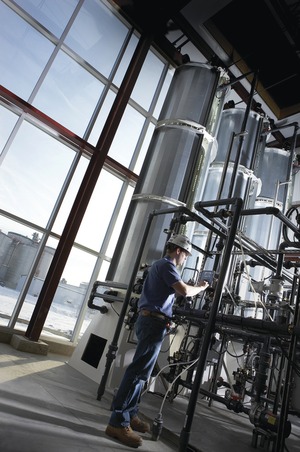
Green Plains Renewable Energy, the nation's largest ethanol producer, is building what it calls a first-of-its-kind production system to transform algae into fuel. Located at the company's ethanol facility in Shenandoah, Iowa, the five-acre installation soon will be integrated into the flows of the ethanol plant.
The modular-based algae system, designed by Rhode Island's Bioprocess Algae, has become a viable solution for industrial facilities looking to add additional revenue streams and mitigate carbon dioxide emissions.
In late February President Barack Obama touted algae as a new fuel feedstock and said renewable fuels were increasingly important because the U.S. could not "drill its way to lower gas prices." This prompted sharp criticism from opponents in Congress and 2012 presidential candidates, such as Newt Gingrich, who called the policy "weird," "out of touch," and a "pipe dream."
Price estimates peg the production cost of a gallon of oil from algae biomass between $5.50 and $6 per gallon, says Riggs Eckleberry, CEO of algae technology firm Origin Oil, Los Angeles. As a result, algae is not yet a suitable feedstock for gasoline and diesel fuel conversion. However, the animal feed, nutraceutical and chemical sectors are starting to offer prices for raw materials that allow for the increased commercialization of algae projects.
In Shenandoah, the algal biomass that is harvested by GPRE would be sold at wholesale as either a dry flake or a "goop" similar in consistency to toothpaste, says Jim Stark, a GPRE spokesman. "We can get better prices for those than we can for oil."
Colocating algae systems with industrial facilities is also a key strategy for commercialization, experts say. Ethanol plants support algae production because they produce ample amounts of carbon dioxide and wastewater—two of the primary ingredients needed for successful, low-cost algae cultivation.
Scale is another factor. Eckleberry notes that the cost of algae production ranges from $1 million per hectare to $5 million per hectare. "The economics are better if you build a bigger system," he says. "At 50 hectares, the cost goes way down. But if you are only building one or two hectares, they might cost you $5 million each." GPRE would not provide a capital estimate for the cost of its project. "That is one of the items to finalize as we build out the five-acre production facility," Stark says.
Because of the intense capital investment, owners say they prefer fixed-price contracts—GPRE would not disclose its EPC provider—because financing these projects is a challenge in the current economic environment. "They can't guarantee the technology, so [tech] companies try to tell their investors exactly what the project is going to cost," says Doug Dudgeon, vice president of emerging technologies at Harris Group, Seattle.
In an effort to keep down costs, Bioprocess Algae developed a modular plant to ease work for designers and contractors. "The majority of engineering work involves integrating the system into siphoning carbon dioxide off the fermentation process and understanding the flow of the ethanol plant. Your system can't have any invasive features," says Tim Burns, CEO of Bioprocess Algae. " We've really tried to offer a plug-and-play technology, which lends itself well to regional builders who can handle the permitting, design and installation."
Harris says that designers and builders who can leverage experience from the wastewater treatment and carbon mitigation sectors will have success developing their participation in this sector. "It's an area of increased activity for us, and we've been involved in several pilot-scale and demonstration projects already," Dudgeon says.


Post a comment to this article
Report Abusive Comment